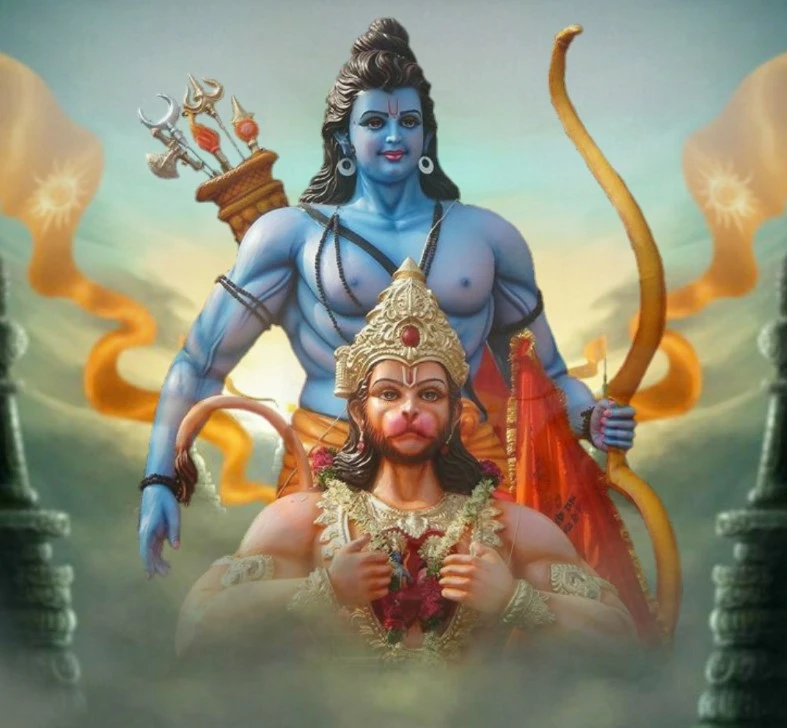Also known as Pavanputra, Kashtbhanjan Dev, Bajrangbali is a central figure in Hindu mythology, celebrated for his unparalleled devotion, immense strength, and tireless service. His story is richly detailed in the epic Ramayana, as well as in various other Hindu scriptures.
Birth and Early Life:

Hanuman was born to Anjana and Kesari. Anjana, a celestial nymph, was cursed to live on Earth, and Kesari was a powerful Vaanara (monkey) king. They are also known as the Son of Vayu, the wind god, who blessed Anjana, making Hanuman Vayuputra (son of Vayu).
From an early age, One famous incident from his childhood involved him leaping towards the sun, mistaking it for a ripe fruit. Indra, the king of gods, struck him with his thunderbolt (Vajra), causing Hanuman to fall and injure his jaw (Hanu), thus giving him the name Hanuman.
Education and Powers:
Received education from various gods and sages, learning scriptures, combat skills, and other arts. He was blessed with immense strength, wisdom, the ability to change his form at will, and speed. His devotion to learning and his innate powers made him a formidable figure in Hindu mythology.
Role in the Ramayana:
They play a pivotal role in the Ramayana, particularly in the search for Sita, the wife of Lord Rama, who was abducted by the demon king Ravana. Hanuman’s journey to Lanka (modern-day Sri Lanka) is one of the most celebrated tales.
Meeting Sita:
They crossed the ocean in a single leap to reach Lanka. Once there, he located Sita in Ashok Vatika, Ravana’s garden, and presented her with Lord Rama’s ring as a token of his assurance. Sita gave them her Anguthi (a jewel Ring) to show to Rama, as a sign of their meeting.
Demonstrating Strength:
Their strength and bravery were on full display in Lanka. He allowed himself to be captured to meet Ravana, then used his powers to burn down a significant part of Lanka with his fiery tail, creating havoc among the demons.
The Sanjeevani Herb:
During the battle in Lanka, Rama’s brother Lakshmana was severely injured by an arrow from Indrajit, Ravana’s son. Hanuman was tasked with fetching the Sanjeevani herb from the Himalayas to heal Lakshmana. When he couldn’t identify the specific herb, Hanuman lifted the entire mountain and brought it back, saving Lakshmana’s life.
In the Mahabharata:
Hanuman also appears in the Mahabharata, another major Hindu epic. He meets Bhima, one of the Pandava brothers, demonstrating his strength and humility. He also blesses Arjuna and promises to be present on Arjuna’s chariot during the Kurukshetra war, ensuring victory for the Pandavas.
Immortality and Devotion:
They considered a Chiranjeevi by Lord Rama, an immortal being, believed to live eternally. His unwavering devotion to Lord Rama is a cornerstone of his legend. Hanuman’s life is a testament to the power of bhakti (devotion), valor, and selfless service.
Worship and Significance:
Hanuman is worshipped widely across India and beyond, particularly on Tuesdays and Saturdays. Devotees recite the Hanuman Chalisa and read the Sundara Kanda from the Ramayana. He is invoked for strength, protection, and the removal of obstacles. Temples dedicated to Hanuman can be found throughout India, with some of the most famous ones being in Hampi, Gujarat, and Maharashtra.
Legacy:
Their legacy is that of an ideal devotee and a symbol of strength, courage, and loyalty. His tales of bravery and devotion continue to inspire millions. Hanuman represents not just physical power but also mental and spiritual fortitude.
Through his life and actions, Veer Putra teaches the values of unwavering faith, loyalty, courage, and the importance of selfless service. His story remains a guiding light for devotees, embodying the essence of true devotion and righteousness.
2 thoughts on “Lord Hanuman; Know about the Veer Putra Bajrang Bali”